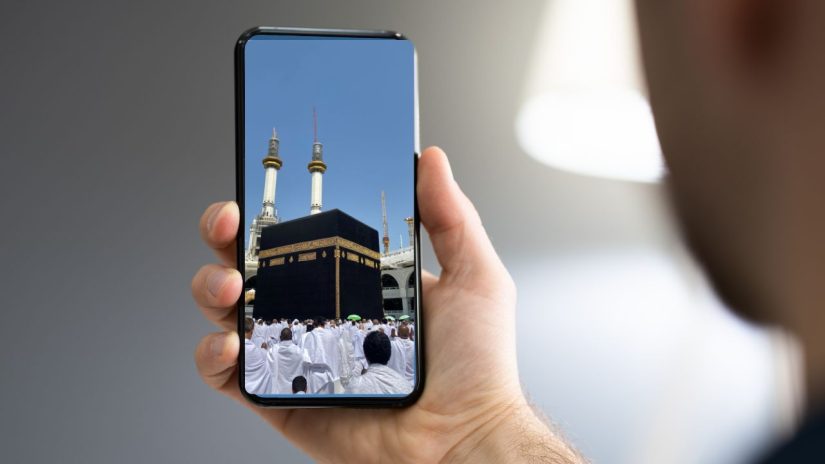
Hongsok Lee
The last presenter at the Wednesday Forum was Subkhani Kusuma Dewi. She teaches in the Hadith Department at UIN Sunan Kalijaga and recently completed her PhD study at Western Sydney University. Her research focuses on Sufi-based practice of short pilgrimage to Mecca (umrah) in the interweaving pilgrimage field of Java, Indonesia. Her work contributes to current discussions on digital anthropology and material religion by using hybrid ethnography tools in the context of the pandemic.
Her presentation is part of her thesis about the practice of the Umrah pilgrimage to Mecca. The COVID-19 pandemic has significantly changed the practice of the pilgrimage among Indonesian Muslims. She argues that the Internet media sector has emerged as a developed economic sector in this practice, which has increased significantly during the pandemic. Her research has uncovered two notable changes in Indonesian practitioners. The first change occurred during the transition to the new normal, face-to-face engagement was replaced by a reliance on virtual modes of pilgrimage. Indonesian travel agencies developed a phenomenon among pilgrims called networked individualism (networked community; Campbell, 2022), where individuals and leaders stay in their own spaces and maintain virtual religious gatherings. Second, the pandemic has contributed to the rise of proxy pilgrimages, where religious leaders represent pilgrims and provide live-streaming options. While the recent phenomenon has resulted in some modifications to Islamic guidelines (Badal Hajj/Umrah), pilgrims’ interest in new ways of traveling attests to a changing perception of the spatiality and materiality of the Indonesian Muslim pilgrimage to Mecca.
It is interesting that she chose hybrid ethnography as her research method, which is not unrelated to the fact that her fieldwork period overlapped with the COVID-19 period. Muslims emphasize pilgrimage primarily through physical encounters. Many see virtual or cyberspace pilgrimage as not replacing physical connection to the holy places (Arjana, 2017). However, MacWilliams (Norman & Cusack, 2015) cites Benedict’s (1991) statement that cyberspace symbolically replaces physical space and closely links the human mind to religion to explain how people move in terms of physical or virtual pilgrimages. According to MacWilliams, people who belong to religious groups use unique “navigators” to make their pilgrimages. McWilliams identifies the internal autonomous structure of religious pilgrimages and emphasizes the influence of economics, politics, and cyberspace as factors contributing to heterogeneous fields. Examining the expansion of certain fields in cyberspace in light of Bourdieu’s concepts, we see that media occupies a prominent position in the heterogeneous pole of growing fields.
Digital technologies and social media are essential to facilitating the pilgrimage market. Social media use is widespread among pilgrims, despite criticism that it undermines sacred sites and experiences (Stanton, 2019). Pilgrimages to the Holy Land are one of the risky and highly contagious mass gathering events that have been heavily impacted by the COVID-19 pandemic. Authorities in the Kingdom of Saudi Arabia (KSA) delayed the entry of foreign pilgrims, suspended all activities around Mecca and Medina, and locked down the country (June 2020), resulting in a year-on-year drop in pilgrimage arrivals of up to 99.7% (Saudi Umrah Statistics 2021). An estimated 18,589 Indonesian pilgrims were evacuated from Saudi Arabia, 2,393 Indonesian pilgrims had to cancel their trip (Kementrian Agama RI, 2022), and pilgrimage providers were forced to diversify their offerings (Hay, 2020). This was a time when the physical pilgrimage became unsafe, forcing pilgrims to disconnect from the Holy Land.
During the forced immobility phase (around 2020–end of 2021), Indonesian pilgrimage providers offered pilgrimage Badal services. The presenter began her observations by focusing on several Indonesian Muthawwifs in Mecca and Medina. Despite the ongoing controversy in the media, pilgrims continued to demonstrate a strong desire to connect and access activities around the Holy Land.
The expanding economic field of Indonesian pilgrimage practice in cyberspace has created more room for individuals to exchange for capital. This growing field offers new habits for internet-savvy individuals and opens up the possibility of religiously reinterpreting rituals. The practice and broadcasted proxy Umrah (badal) on vlogs drew viewers’ emotions and sensory experiences of facing the Kaaba during the forced immobility phase. Muthawwifs’ language expressions (e.g. Prayers being recited, body language and gestures, facial expressions, and way of clothing) effectively capture viewers’ intense feelings. This evidence suggests that networked individuals perceive social media as a means to reconnect with Mecca, allowing them to express the emotional connection they long for with the actual trip. The “always-on” or “24/7 online” of individuals in cyberspace, as Bunt (2009) refers to it, has enabled the process of preserving new religious habitus while accelerating networked individuals during the pandemic, with mobile devices, the ubiquitous availability of broadband internet, and the rise of social networks as a medium of connection.
Her research can be summarized as follows: 1. As the economic domain of pilgrimage expanded into cyberspace, networked individuals came to assign specific mediated religious practices to themselves. 2. While Bourdieu’s perspective sees cybermedia encounters as a growing space for accessing and exchanging agentic capital, pilgrimage guides who broadcast pilgrimages effectively provided a dominant social status and role in established governmental authority. 3. The fluidity and adaptability of networked individuals in hypermediated religious gatherings expanded a relatively flexible religious authority that could adapt to the needs and interests of its audience.
